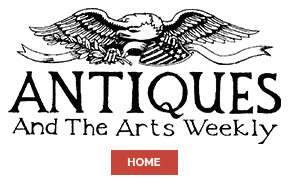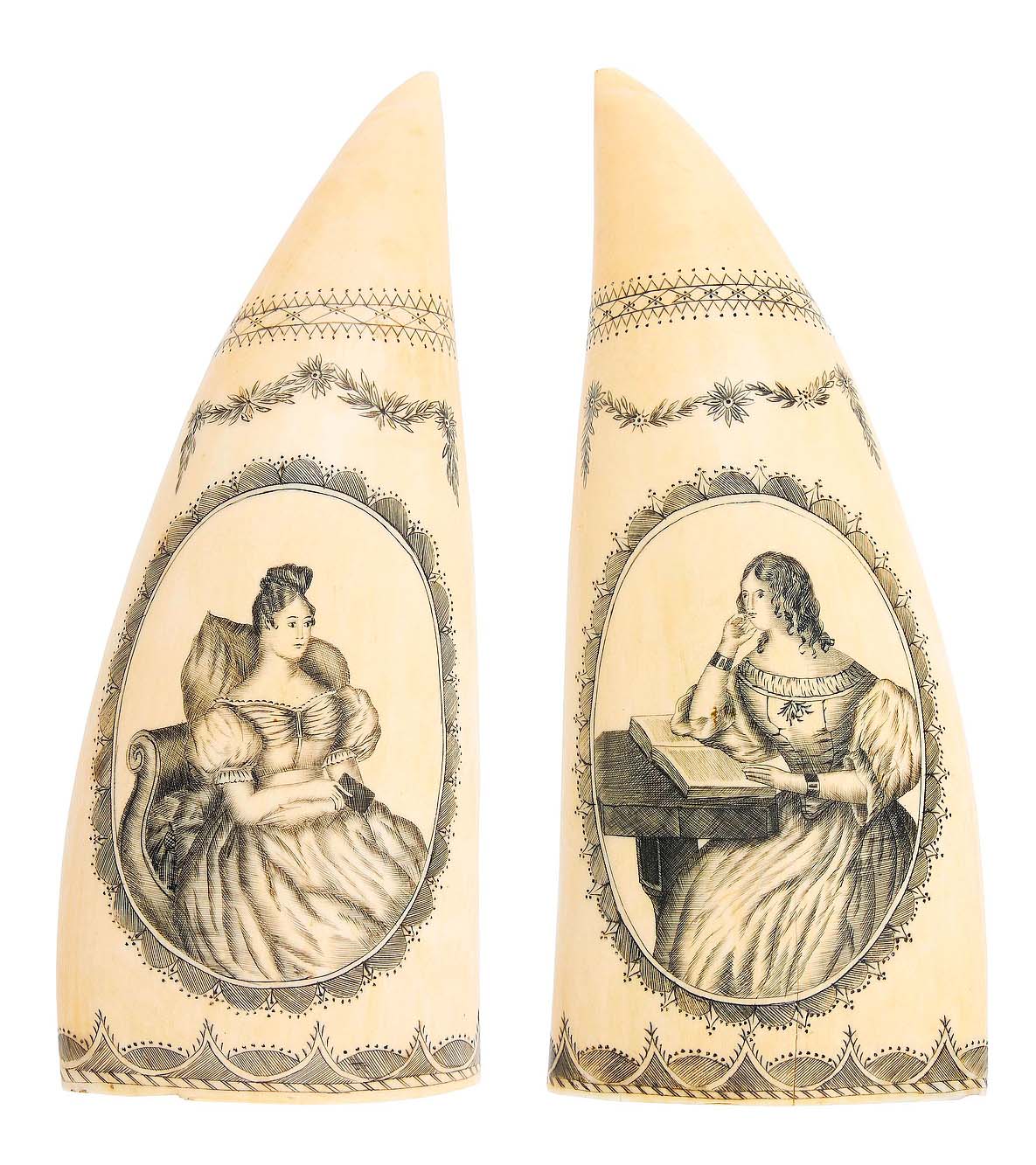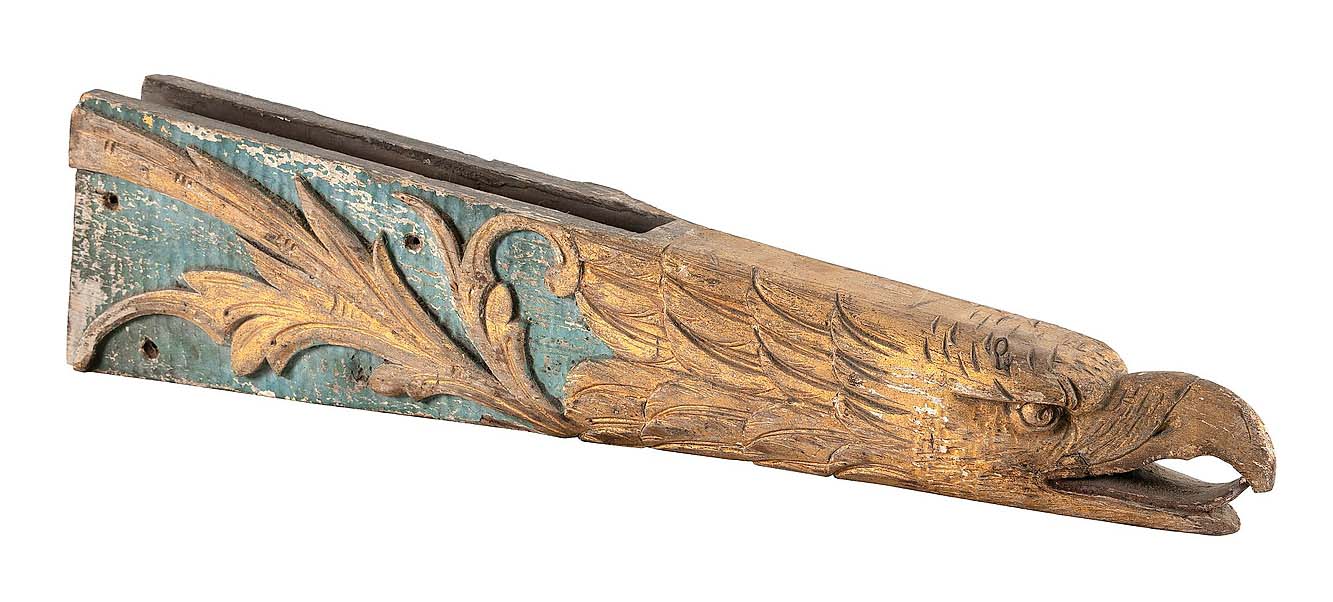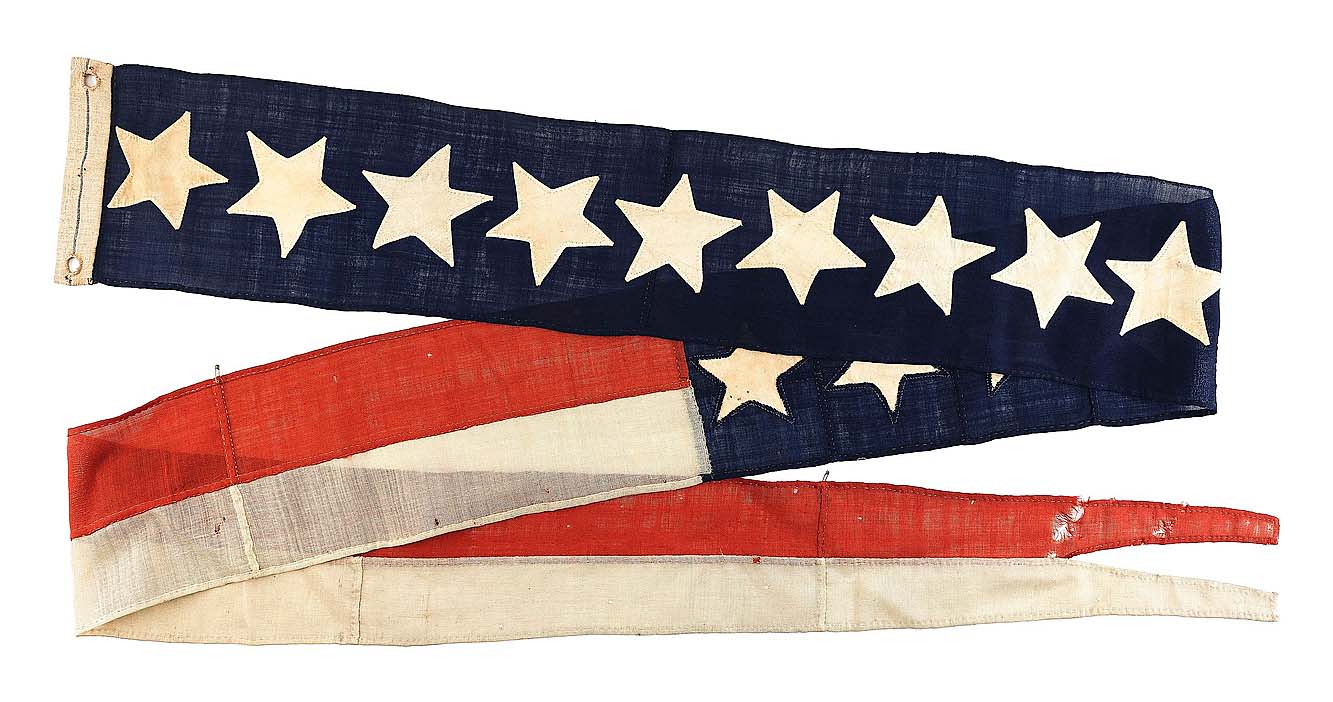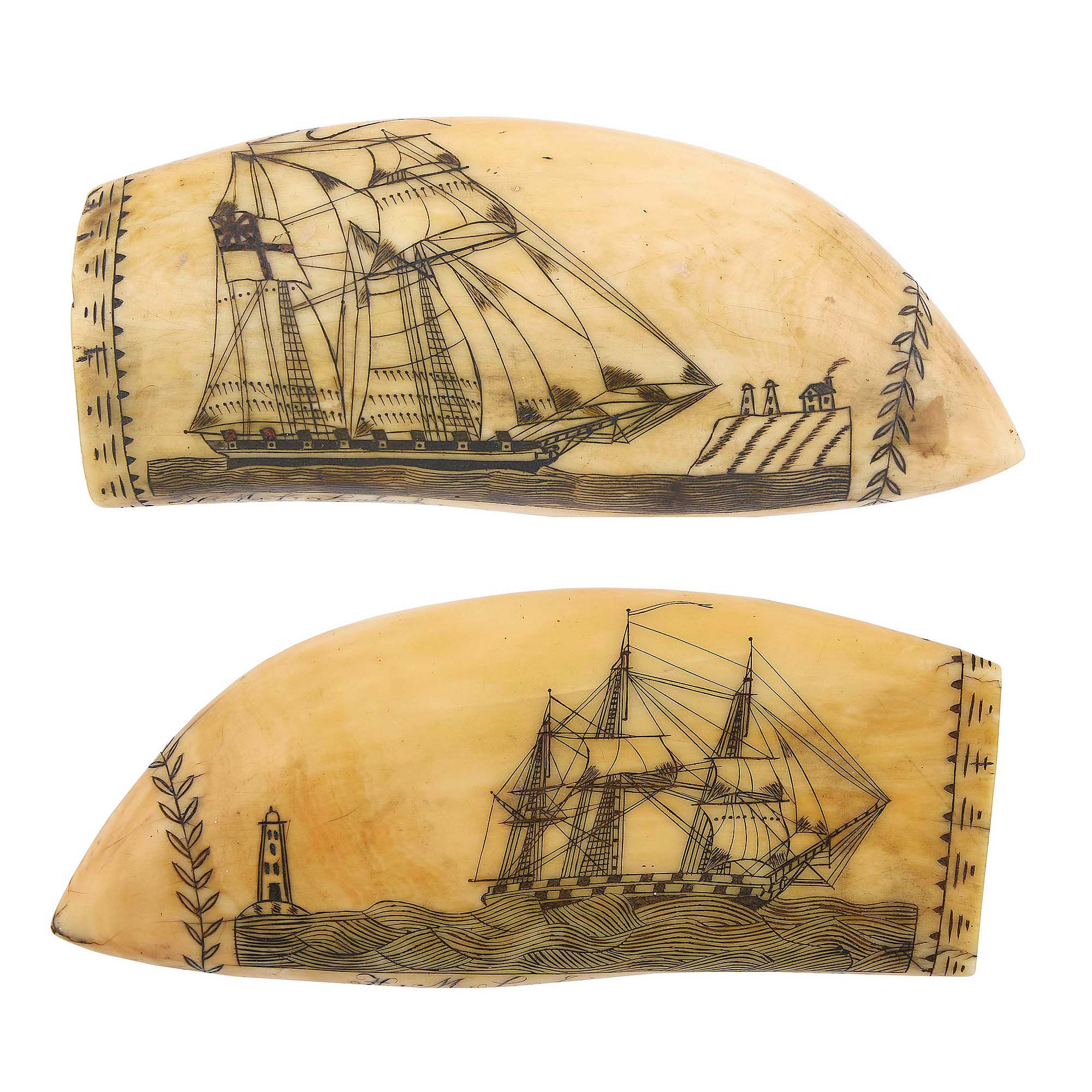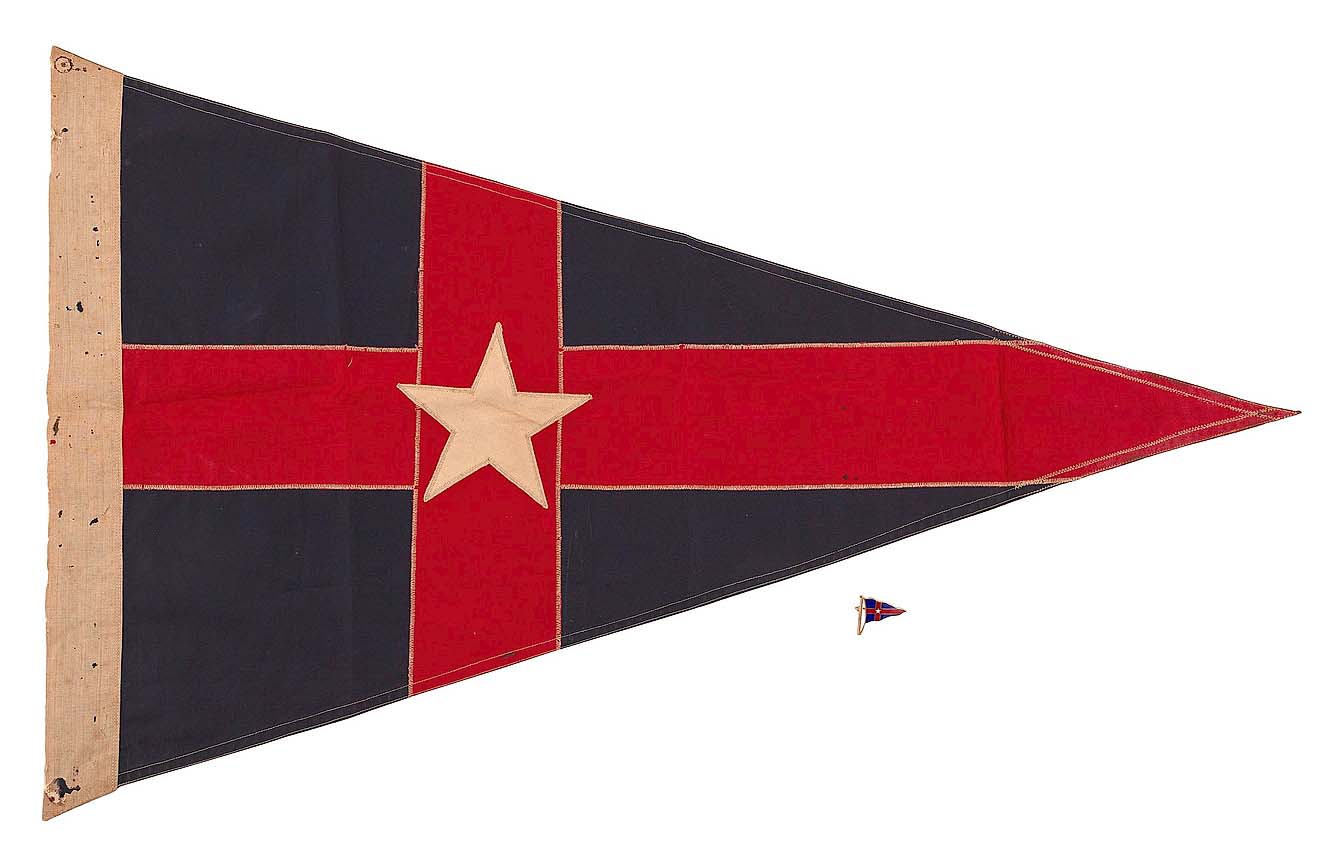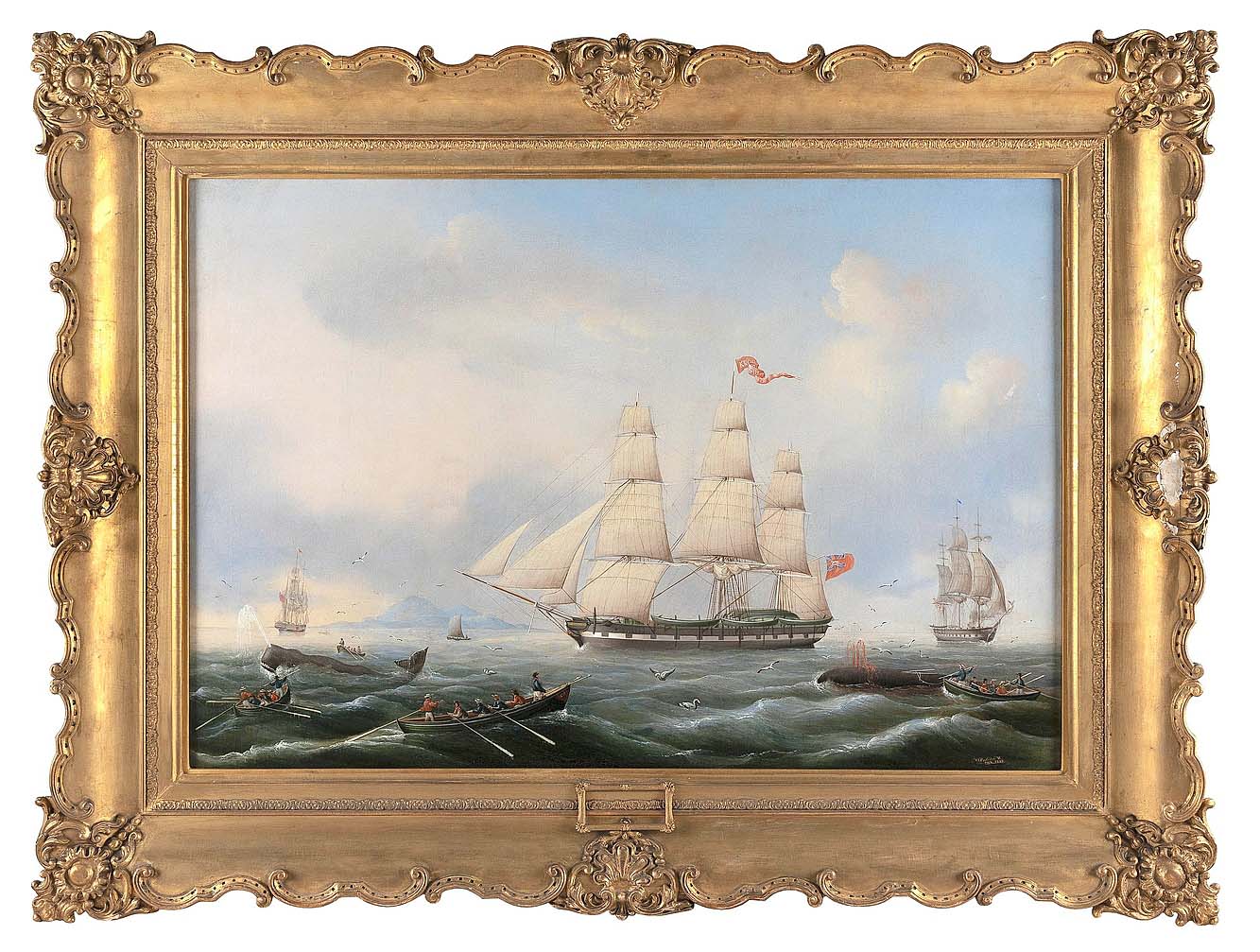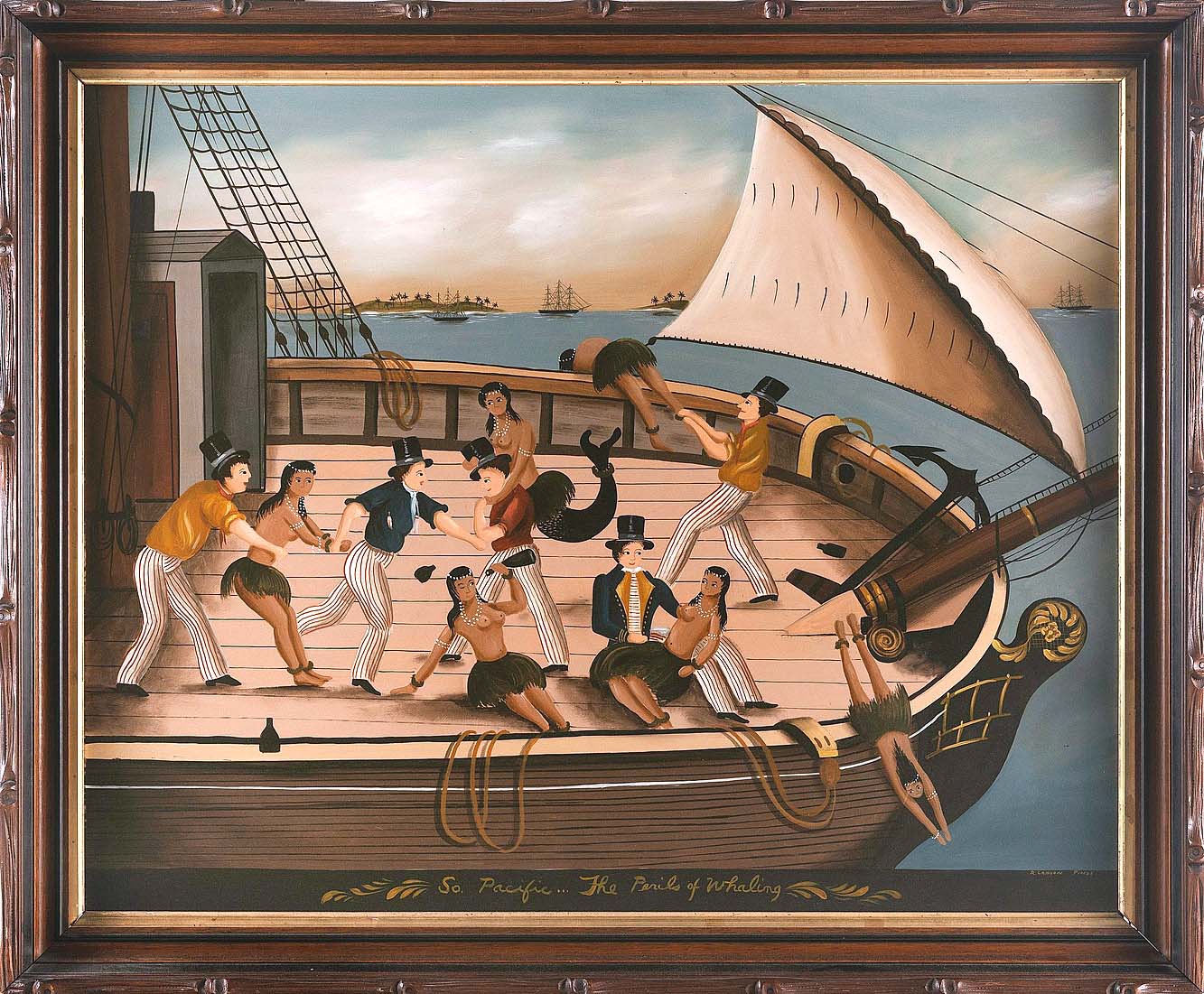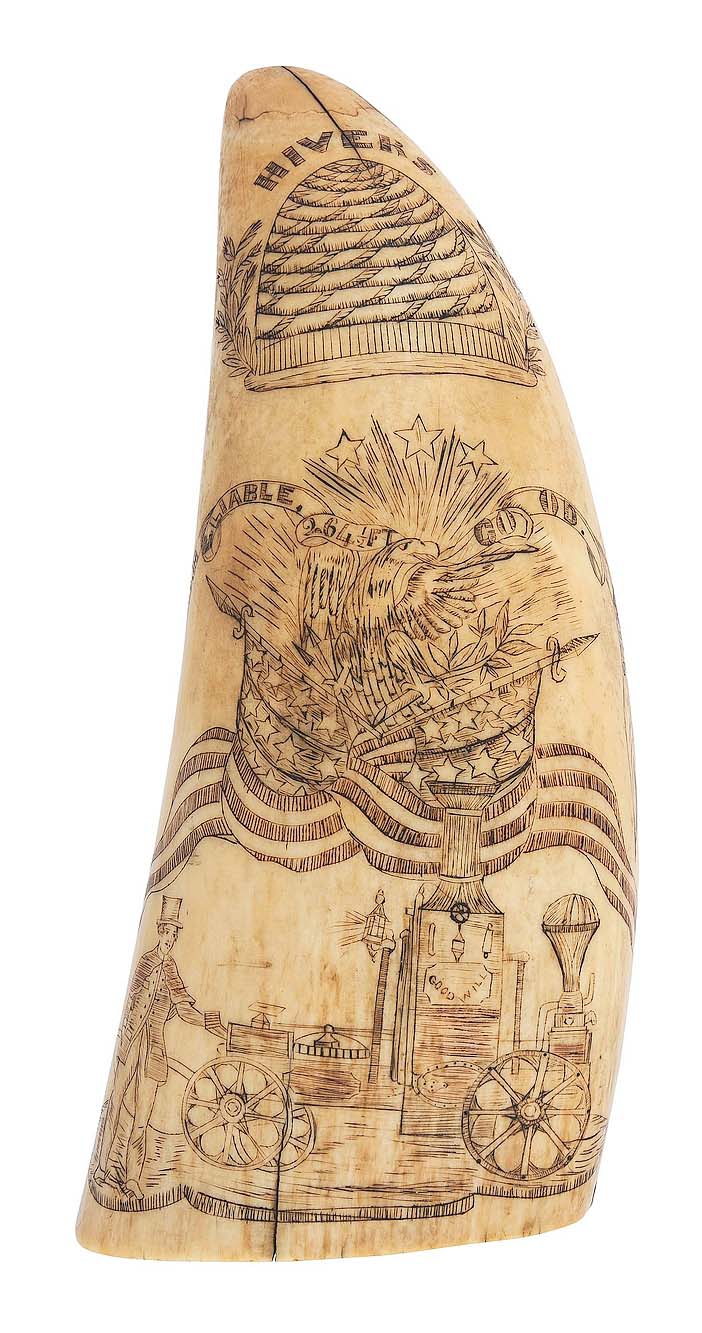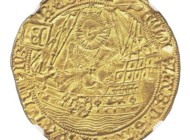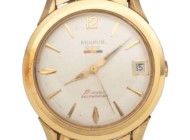
This scrimshaw whale’s tooth “Executed by G.W. Lewis, 1849,” mid Nineteenth Century, 7½ inches long, was the top lot of the sale at $88,200 ($40/60,000).
Review by Carly Timpson
EAST DENNIS, MASS. — One of Eldred’s most anticipated events of the year, the firm’s annual Marine Sale took place August 7-8 this year, offering 516 lots of marine art, scrimshaw, whaling items, nautical collectibles and decorative arts. In total, the auction realized $1.74 million and had an 86 percent sell-through rate.
Earning the highest price was a mid Nineteenth Century scrimshaw whale’s tooth signed and dated “G.W. Lewis / 1849.” Cheryl Stewart, Eldred’s head of marketing, reported: “The large tooth, length 7½ inches, was covered in ship portraits, flags and other patriotic and nautical motifs. It was from the scrimshaw collection of Mr and Mrs John Miklos, and it sold in the room to a private collector for $88,200 on a $40/60,000 estimate.” In addition to the marine and patriotic images, the tooth was etched with a depiction of Christ on the cross, the fraternal symbols, a military encampment, a mermaid and banners reading “U.S. / Brig / Dolphin.” The catalog noted that this tooth was illustrated in Alan Granby’s Wandering Whalemen and Their Art: A Collection of Scrimshaw Masterpieces (Hyannis Port, Mass.:, 2021) and that “G.W. Lewis is believed to be George W. Lewis, who served aboard the whaleship Saratoga out of New Bedford on an 1849 voyage. He survived the wreck of the ship City in 1854, which apparently ended his whaling career. He ended up on Nantucket and served with the island’s militia.” It was also noted that the US Navy brig Dolphin was launched in New York in 1836 and was active until 1860.
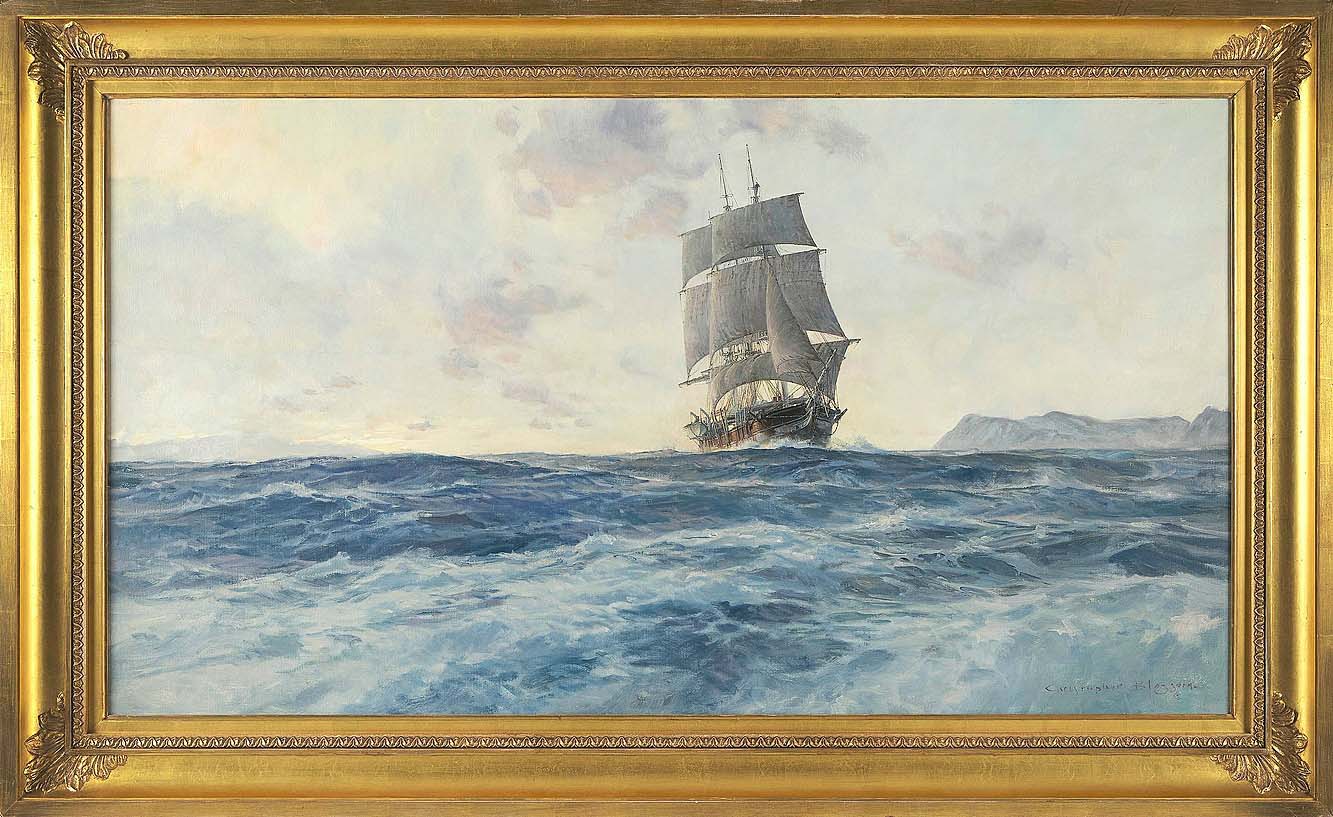
Besting its $10/15,000 estimate, Christopher Blossom’s (Connecticut, b 1956) “The Bark Superior in the Bering Strait,” oil on canvas, 31 by 51 inches framed, sailed home for $18,900.
Several additional notable results came from the Miklos scrimshaw collection, including the next two highest prices in the auction. At $81,900 was a pair of teeth done by the Banknote Engraver. These mid Nineteenth Century whale’s teeth each featured medallion portraits on one side and marine scenes on the other. One had a scene of the War of 1812, showing the battle between the ships Chesapeake and Shannon, based on an image from Abel Bowen’s The Naval Monument (1836). The other showed an American ship assisting a lifeboat of British sailors evacuating a British ship flying its red ensign upside-down, indicating its distress. The portraits were each of seated women and were surrounded by floral garlands and border details. These two were also shown in Granby’s Wandering Whalemen.
Posting the third-highest price of $63,000 was a pair of patriotic teeth, scrimshawed with full-length polychrome depictions of allegorical figures. One of the teeth featured Lady Liberty, shown draped in a red, white and blue American flag and holding a shield in one hand and a long pole in the other, while the other tooth depicted Lady Justice holding up the balance scales in one hand and with a sword in her other. Notably, Justice is not shown blindfolded, rather she looks toward Liberty on the other tooth.
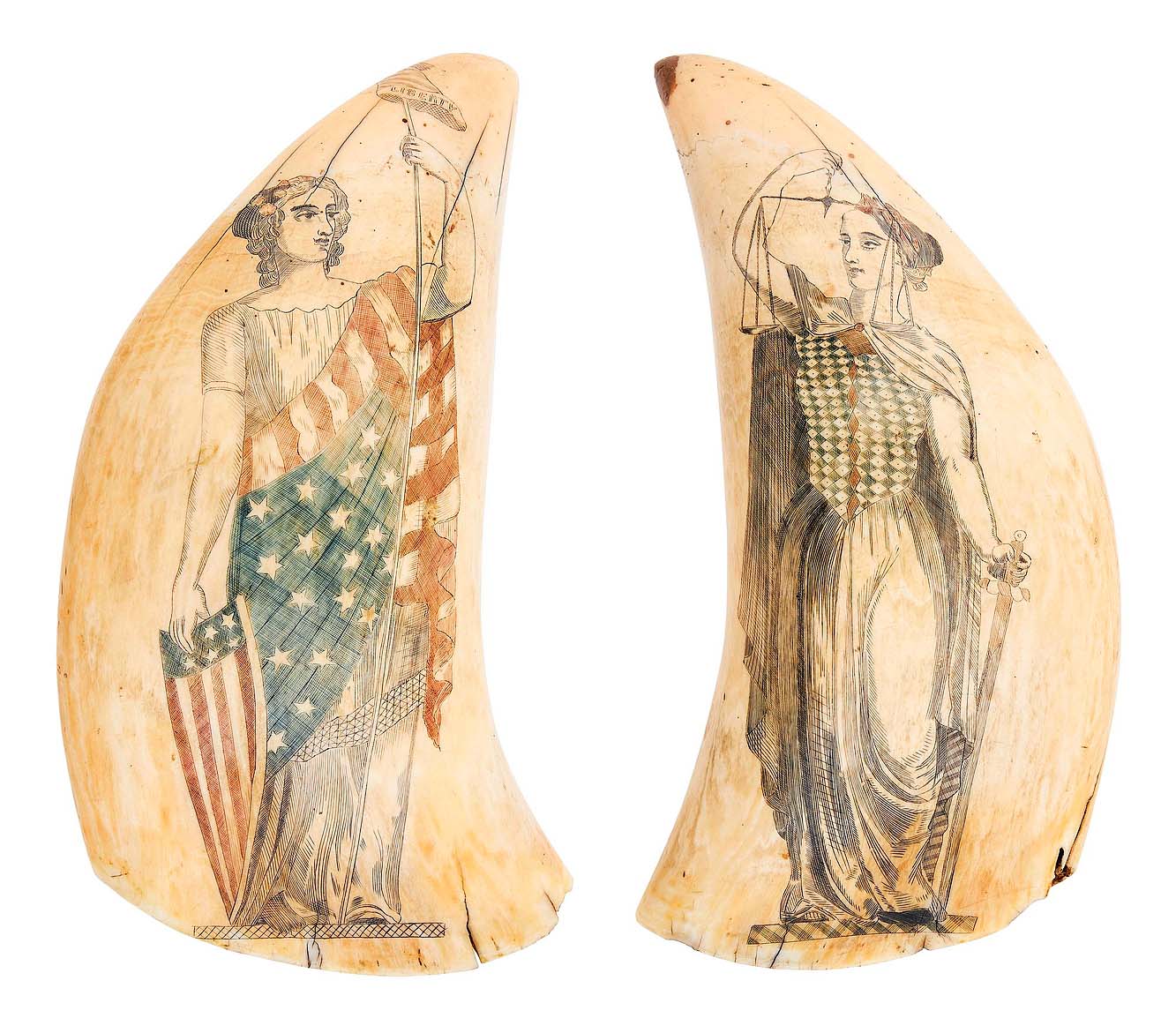
Full-length polychrome portraits of Lady Liberty and Lady Justice decorated these teeth, both approximately 7¼ inches, mid Nineteenth Century; they were taken to $63,000 ($50/70,000).
A circa 1830 tooth showing ships of the British Royal Navy by the Brittania Engraver also came from the Miklos collection. This example had two ship portraits, one on each side. The obverse showed HMS Sealark with twin lighthouses and the keeper’s house in the distance, possibly the Flamborough Head Lighthouse in Yorkshire. The reverse image showed HMS Isis, or Iris, and a lighthouse, possibly Eddystone south of Rame Head, Cornwall. Both ships were named in script on the underside and leaf garlands were used as borders and accents. A bidder claimed the tooth for a royal $25,200.
Though not from the Miklos collection, scrimshaw collectors also took a liking to a highly detailed, polychromed whale busk. Measuring 13½ inches long, the busk had several vignettes, each separated by a red harlequin-style border. Bookended by small pairs of forget-me-nots, from top to bottom the busk showed a basket of blue flowers, a bird on a leafy branch, two whaling scenes and a pair of whale silhouettes. This colorful busk rose well beyond its $10,000 high estimate, ultimately achieving $56,700.
For fans of maritime art, the collection of George Lewis from Sherborn, Mass., contributed several selections by English-born, Massachusetts-based painter Robert Salmon.
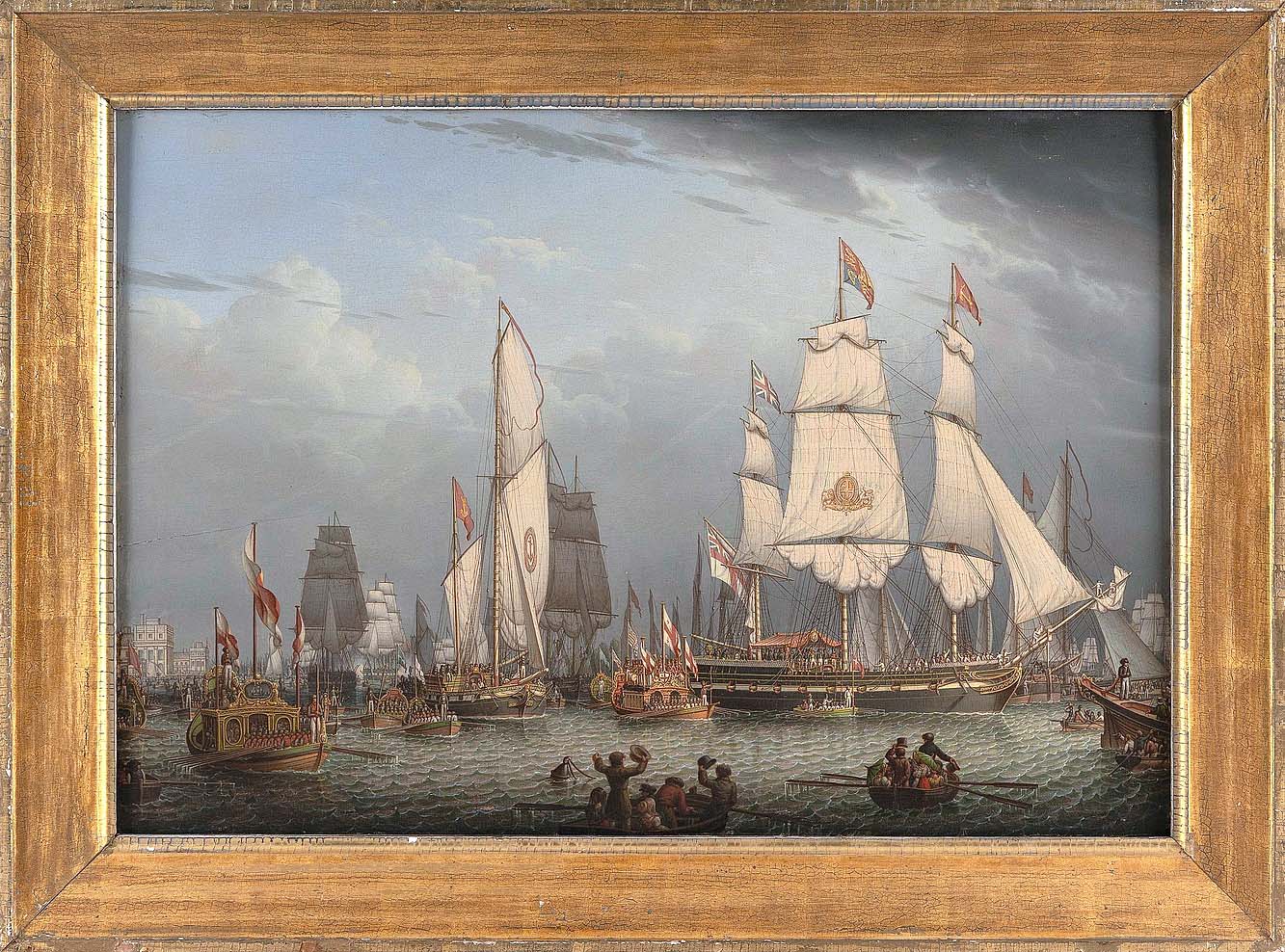
Leading the paintings category at $56,700 was “Celebration at an English Port” by Robert Salmon (Massachusetts, 1775-1844), 1836, 21½ by 28¾ inches framed ($50/70,000).
Leading this collection was Salmon’s 1836 oil on panel titled “Celebration at an English Port.” The catalog description called this “A superior example of Nineteenth Century marine paintings and one of the finest and most complex works we have seen by Salmon, detailed to such an extent the water is seen dripping from the oars.” The scene showed a historically significant event in a harbor filled with royal barges and other vessels crowded with figures. The work was signed to the lower right and was inscribed “No. 868 / Painted by Robert Salmon 1863” to the reverse.
From the years 1807 to 1840, Salmon kept a journal recording most of his paintings by number, from one to 999. According to the auction catalog, “He typically would include the painting’s size, title and number of days it took to paint, and if he sold it, he would sometimes include the price.” A copy of this original journal is in the collection of the Boston Public Library, so many of his paintings done during this time can be identified and correctly cataloged.
Other Salmon works from the Lewis collection included “Boston Light,” done circa 1840 and not numbered, and “Squantam Rock,” dated “1843” and numbered “No. 530” to the reverse. “Boston Light” shows a calm view of a small ship on the water heading toward the second-oldest working lighthouse in the US; this oil on panel was bid to $47,250. “Squantam Rock,” a view of the Squantum Peninsula in Quincy, Mass., was shown at the Fourth Exhibition of the Massachusetts Charitable Mechanics Association in 1844 and was illustrated in Flying the Colors: The Unseen Treasures of Nineteenth Century American Marine Art by Alan Granby and Janice Hyland (Mystic, Conn.: Mystic Seaport, 2009). It finished, just above its low estimate, for $40,950.

“Boston Light” by Robert Salmon (Massachusetts, 1775-1844), circa 1840, oil on panel, 20¼ by 23½, found a new home for $47,250 ($30/50,000).
Dating to the last quarter of the Nineteenth Century, a carved and polychromed eagle billethed attributed to John Haley Bellamy led the charge of decorative objects from ships at $32,760. The golden-headed eagle was depicted with an open beak, though about a quarter of an inch of the beak had broken off. The sides had golden relief-carved acanthus leaves against a blue ground.
Also from a ship was a 13-star commissioning pennant from the Nineteenth Century. This swallowtail pennant was approximately 11 feet 9 inches long and showed the 13 white stars in a single line on a blue ground, finishing with a horizontal red-over-white striped tail. This pennant flew to $26,460, far exceeding its $1,000 high estimate. Another flag, though this one for leisure or sport rather than marking a Naval vessel, was claimed for $23,940. This example was a New York Yacht Club burgee, featuring the club’s red cross on a blue ground, with a white star in the center of the cross. Sold with the early Twentieth Century burgee was a matching 14K yellow gold pin.
Standing at 81½ inches high on a custom wooden stand, a narwhal tusk certainly made an impression on bidders. Estimated $10/12,000, the tusk did better, achieving $18,900. “It sold to a Massachusetts buyer. Because it is a piece of unworked marine ivory, the sale was restricted to Massachusetts residents per Federal Regulation.” According to Stewart, “The market for narwhal tusks, even with the intrastate commerce restriction, is very strong.”
Prices quoted include the buyer’s premium as reported by the auction house. Eldred’s next auction, Silver + Vertu, will be September 10. For additional information, www.eldreds.com or 508-385-3116.
